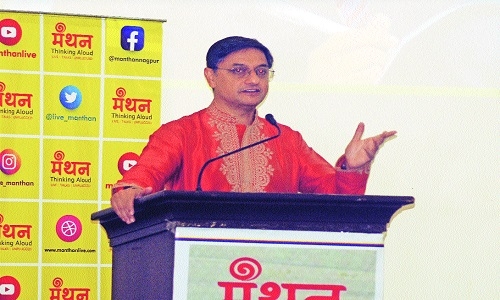Revolutionaries were modernisers: Sanyal
13 Mar 2023 08:38:52

Staff Reporter
“Much of India’s freedom struggle is seen through the conventional narratives, point of views exclusively led by Mahatma Gandhi. But there was another story of armed resistance against British. Armed resistance were not random occasional acts of bravery against British. They were part of the larger movement sustained by men and women, and networks spread across the world,” said Sanjeev Sanyal, Principal Economic Advisor to Government of India, at Chitnavis Centre on Sunday in a session organised by Manthan. Drawing on the lives of revolutionaries such as Aurobindo Ghosh, Sachindra Nath Sanyal, Pandurang Khankhoje, Vinayak Savarkar in his book ‘Revolutionaries: The Other Story Of How India Won its Freedom’, Sanyal narrated the story of how armed resistance played a vital role in India’s freedom struggle.
Elaborating on how revolutionaries and revolutions were emerging across the ocean along the timeline of British Raj, Sanyal said, “The idea of revolution has always been there. The efforts of these revolutionaries may have been put down, but by 1946 when none of these revolutionaries were alive, their literature began to create space in the minds of the people -- beginning with Royal Indian Navy Mutiny.” This led to immediate strikes all over the places.
Sanyal narrated the stories of many networks run by Aurobindo Ghosh, Savarkar, and Rash Behari Bose, Sachindra Nath Sanyal, and Dr KB Hedgewar across the world which led to many organised armed resistance against the British. “These revolutionaries were modernisers -- looking into the future. With religious revivalism happening in the backdrop of an emerging revolution, many attempts were shot down, but this fire lit by Ghosh created a buzz which finally culminated into India’s freedom.” Through the interwoven, always intermingling timeline of events, international networks, massacres, emergence of Indian National Congress and Azad Hind Fauj and many other organisations, Sanyal narrated a rare tale of history untold -- a history of overarching strategy, espionage, bravery and heroism. “However, Independent India treated revolutionaries shabbily. Many revolutionaries were from Maharashtra, Punjab and Bengal. With partition in play, their women were being raped, children murdered. While Maharashtra was not being divided, Nathuram Godse had just shot Mahatma Gandhi. The events that followed led the country homeless to many of these revolutionaries,” he said.
Pressing on the need to shed light on the untold narratives of history he said, “Indian history has to be reclaimed. We must foster a generation of academicians and researchers or it may lead to negative political consequences.” Revolutio-naries, the fire brand freedom fighters cinched in unpredictable matters of fate, connected in multiple ways in the evolving events of India’s freedom fight is an interesting story that had a significant impact on India’s struggle to freedom. Author Sanjeev Sanyal met with the descendants of Dr Pandurang Sadashiv Khankhoje, Agricultural Scientist and fire brand freedom fighter prior to his session at Chitnavis Centre.